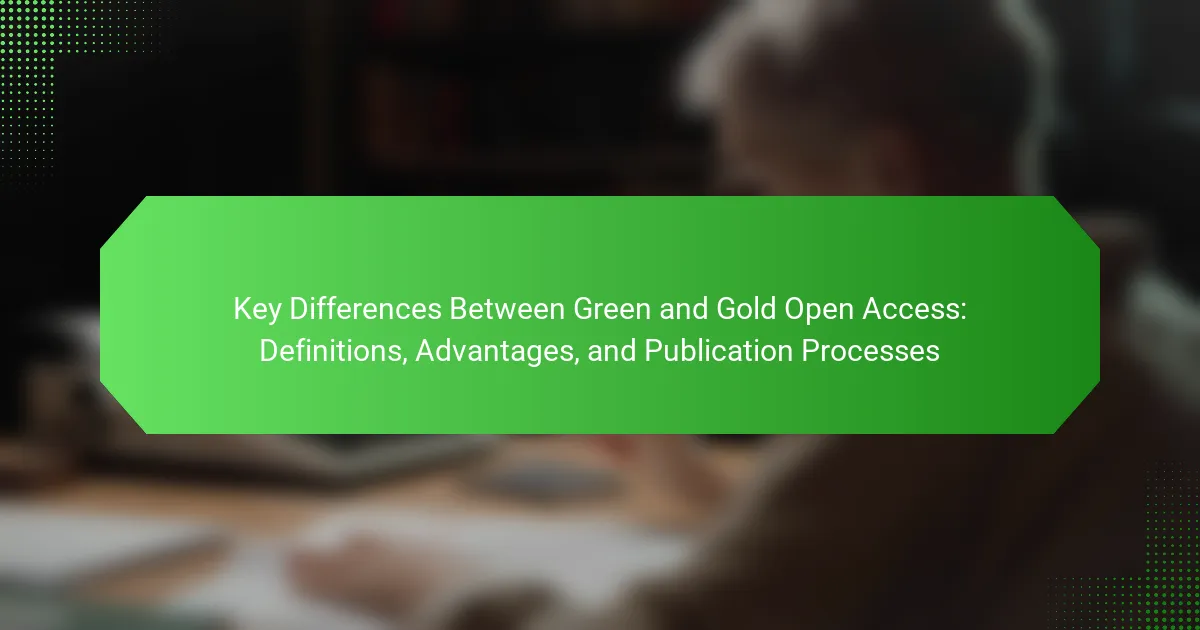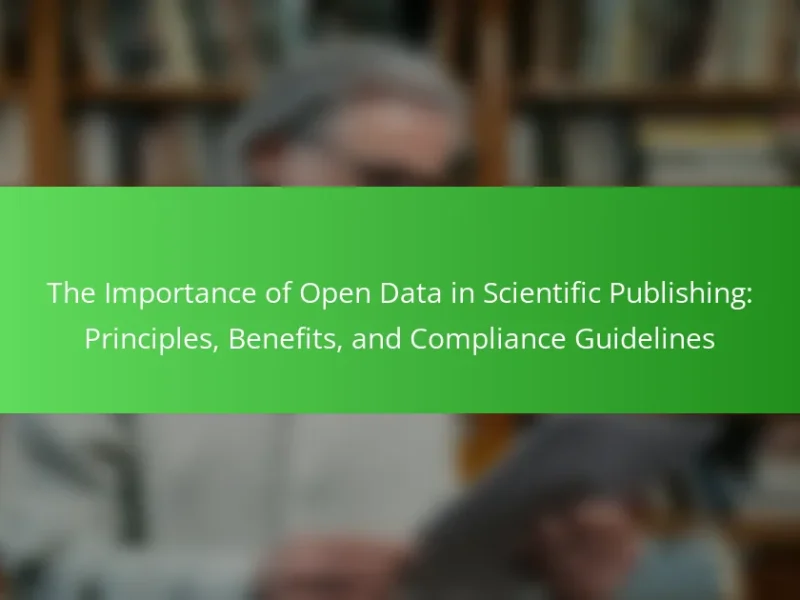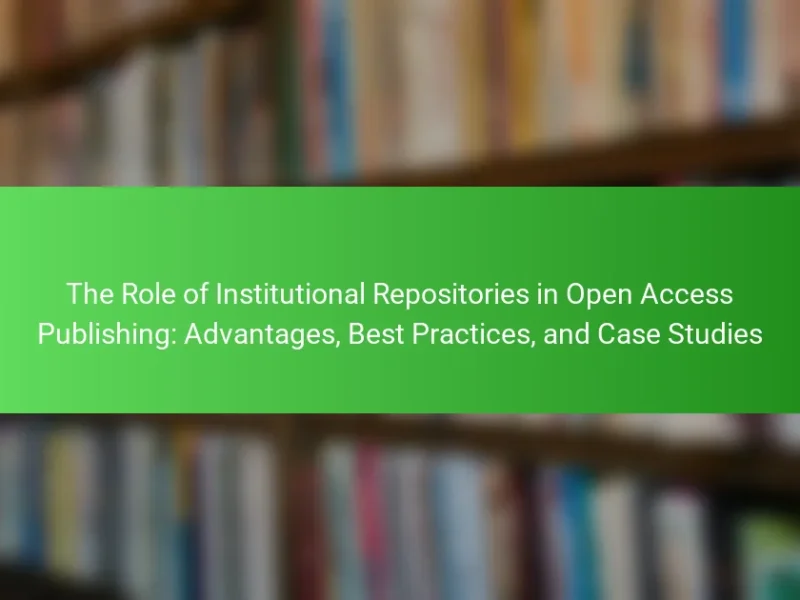The article explores the key differences between Green Open Access and Gold Open Access, two distinct models for making research findings accessible. Green Open Access allows authors to self-archive their work in repositories after a delay, while retaining copyright and sharing under specific conditions. Gold Open Access offers immediate availability of articles in journals, often requiring an article processing charge (APC) paid by authors or institutions. The article outlines the advantages and publication processes of each model, highlighting considerations such as funding availability, visibility, publication speed, and licensing terms that researchers should evaluate when choosing between them.
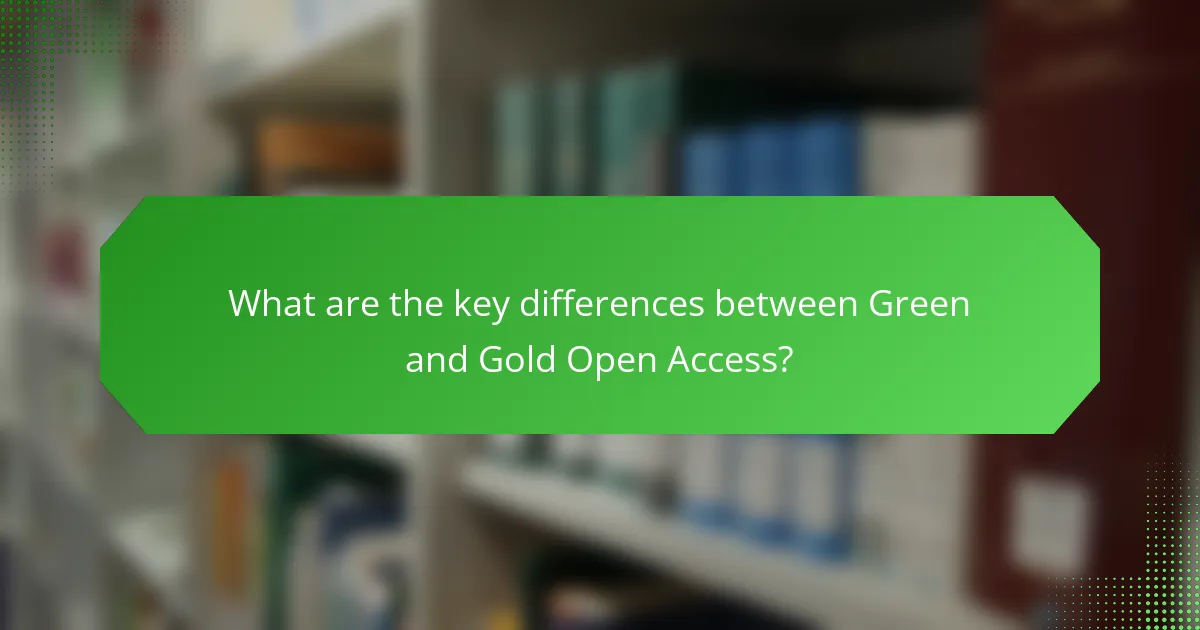
What are the key differences between Green and Gold Open Access?
Green Open Access allows authors to self-archive their work in repositories. This method often involves a delay before the content is publicly accessible. Authors retain copyright and can share their work under certain conditions. Gold Open Access, on the other hand, involves immediate availability of articles in journals. This model typically requires an article processing charge paid by authors or institutions. Gold Open Access journals often provide wider visibility and reach. In contrast, Green Open Access may have limitations on the version of the work that can be shared. Both models aim to enhance access to research, but they differ significantly in publication processes and funding structures.
How do Green and Gold Open Access define their publication models?
Green Open Access allows authors to self-archive their work in repositories. This model typically involves depositing a preprint or postprint version of an article. Authors retain copyright while providing free access to their work. Gold Open Access, on the other hand, requires authors to publish in journals that make articles freely available immediately upon publication. This model often involves article processing charges (APCs) paid by authors or their institutions. Both models aim to increase accessibility and visibility of research. Green Open Access relies on repositories, while Gold Open Access is journal-centric.
What are the main characteristics of Green Open Access?
Green Open Access allows authors to self-archive their work in repositories. This practice promotes wider access to research outputs. Authors retain copyright while sharing their work. The content is usually made available after an embargo period. Repositories can be institutional or subject-specific. Green Open Access supports compliance with funding agency mandates. It enhances visibility and citation of research articles. Studies show that self-archived articles often receive more citations than non-archived ones.
What are the main characteristics of Gold Open Access?
Gold Open Access is a publishing model that allows immediate free access to research articles. It typically involves the payment of Article Processing Charges (APCs) by authors or their institutions. This model ensures that articles are freely available to all readers upon publication. Gold Open Access is often associated with journals that are fully open access, meaning all content is available without subscription fees. The model promotes wider dissemination of research findings. It is supported by various funding agencies that require open access to publicly funded research. Many reputable journals adopt this model, enhancing visibility and citation potential.
What advantages do Green and Gold Open Access offer to researchers?
Green and Gold Open Access provide significant advantages to researchers. Green Open Access allows researchers to self-archive their work in institutional repositories. This increases visibility and accessibility of their research. Gold Open Access, on the other hand, publishes articles in fully open access journals. This ensures immediate and unrestricted access to research findings. Both models enhance the dissemination of knowledge. They also increase citation rates, as open access articles are more frequently cited than those behind paywalls. Additionally, these models can improve collaboration opportunities by making research more accessible to a wider audience.
How does Green Open Access benefit authors and institutions?
Green Open Access benefits authors by allowing them to share their research freely after a certain period. This increases the visibility and reach of their work. Authors can retain copyright while making a version of their work available in repositories. This self-archiving approach also enhances their academic reputation. Institutions benefit by promoting open access to research outputs. This can lead to increased citations and collaborations. Furthermore, it supports compliance with funding agency mandates for open access. Green Open Access is a cost-effective option for institutions to enhance their research dissemination.
What unique benefits does Gold Open Access provide?
Gold Open Access provides immediate and unrestricted access to research articles. This model allows anyone to read, download, and share the work without subscription barriers. It enhances the visibility of research, increasing the potential for citations and impact. Authors retain copyright, often enabling them to share their work freely. Gold Open Access typically involves article processing charges (APCs), which fund the publication process. This model supports the sustainability of journals and promotes a more equitable dissemination of knowledge. Studies show that articles published under Gold Open Access are cited more frequently than those behind paywalls.
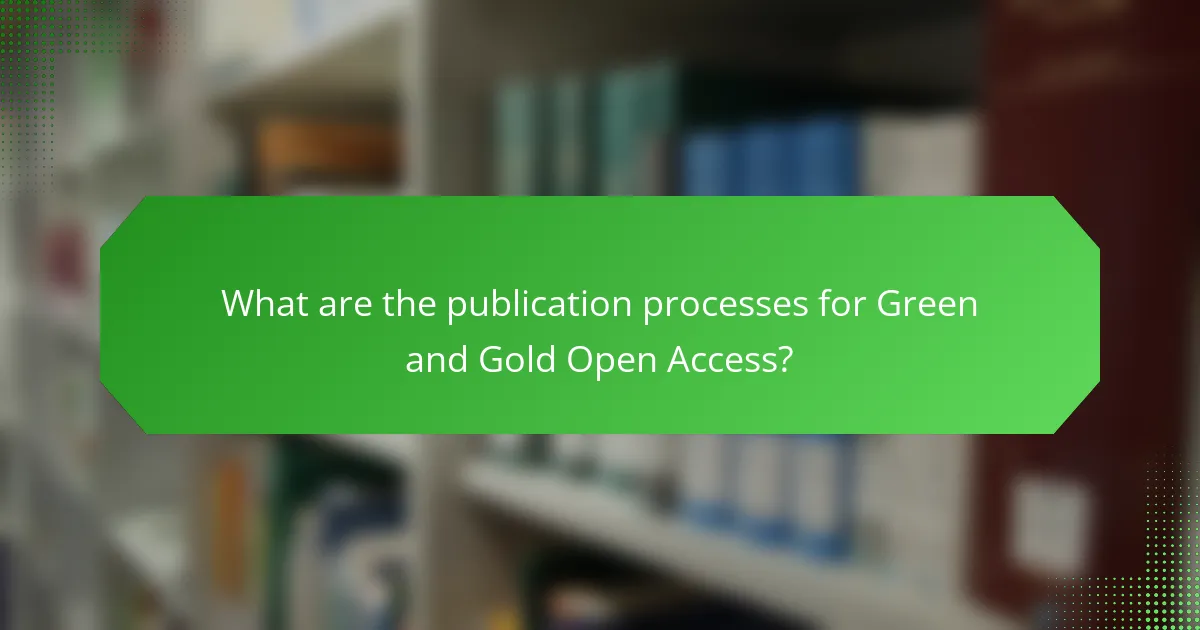
What are the publication processes for Green and Gold Open Access?
Green Open Access involves self-archiving of a manuscript in an institutional or subject repository. Authors typically deposit their accepted manuscripts after peer review. This process allows free public access to research without publisher restrictions. Gold Open Access requires authors to publish in journals that provide immediate open access upon publication. This often involves payment of an Article Processing Charge (APC). The journal’s website hosts the article, making it freely available to all. Both processes aim to increase accessibility to research findings. They differ primarily in the venue and conditions of access.
How does the submission process differ between Green and Gold Open Access?
The submission process for Green and Gold Open Access differs primarily in terms of publication fees and access to the article. In Gold Open Access, authors pay publication fees upfront to make their work freely accessible upon publication. This process typically involves submitting the manuscript to a journal that operates under a Gold Open Access model. In contrast, Green Open Access allows authors to submit their work to traditional journals without upfront fees. Authors can later self-archive their manuscripts in institutional repositories or personal websites, often after an embargo period. This means that while Gold Open Access provides immediate access, Green Open Access may delay public availability.
What steps are involved in the Green Open Access submission process?
The Green Open Access submission process involves several key steps. First, authors submit their manuscript to a journal for peer review. After acceptance, authors check the journal’s policies on self-archiving. Next, they deposit the accepted manuscript in an institutional or subject repository. Authors may also need to provide a link to the published version. Finally, they ensure compliance with any embargo periods set by the journal. These steps facilitate public access to research while adhering to copyright agreements.
What steps are involved in the Gold Open Access submission process?
The Gold Open Access submission process involves several key steps. First, authors prepare their manuscript according to the journal’s submission guidelines. Next, they submit the manuscript through the journal’s online submission system. After submission, the manuscript undergoes peer review, where experts evaluate its quality and relevance. Following peer review, authors receive feedback and may need to make revisions. Once the manuscript is accepted, authors typically pay an article processing charge (APC) to make the work openly accessible. Finally, the article is published and made available to the public without subscription barriers. This process ensures that research is freely accessible, promoting wider dissemination and impact.
What roles do publishers play in Green and Gold Open Access?
Publishers play crucial roles in both Green and Gold Open Access. In Gold Open Access, publishers provide immediate access to research articles, typically requiring authors to pay Article Processing Charges (APCs). This model ensures that articles are freely available to readers upon publication. Publishers also handle peer review, editing, and distribution of these articles.
In Green Open Access, publishers allow authors to self-archive their work in repositories after an embargo period. This model enables wider access while preserving the publisher’s rights. Publishers set the terms for self-archiving, including which versions of the article can be shared and the duration of any embargo.
Both models reflect publishers’ commitment to increasing access to research. They balance the need for revenue with the demand for open access. This balance is essential in promoting scholarly communication and ensuring sustainability in publishing.
How do publishers support Green Open Access initiatives?
Publishers support Green Open Access initiatives by allowing authors to self-archive their manuscripts. This practice enables authors to share their work in repositories or on personal websites. Many publishers provide specific guidelines for self-archiving. These guidelines often outline which versions of the manuscript can be shared. Some publishers also offer embargo periods before the manuscript can be made publicly available. This approach balances the publisher’s rights with the author’s desire for wider access. Research shows that self-archiving increases the visibility and citation rates of published work, benefiting both authors and publishers.
What is the publisher’s role in Gold Open Access publishing?
The publisher’s role in Gold Open Access publishing is to make research articles freely accessible to the public. This model requires publishers to cover the costs of publication through article processing charges (APCs) paid by authors or their institutions. Publishers also manage the peer review process, ensuring quality and credibility. They provide the necessary infrastructure for hosting and disseminating articles online. Additionally, publishers handle copyright and licensing agreements, allowing authors to retain rights while ensuring public access. This model contrasts with subscription-based publishing, where access is restricted. Gold Open Access supports wider dissemination of research, increasing visibility and impact.
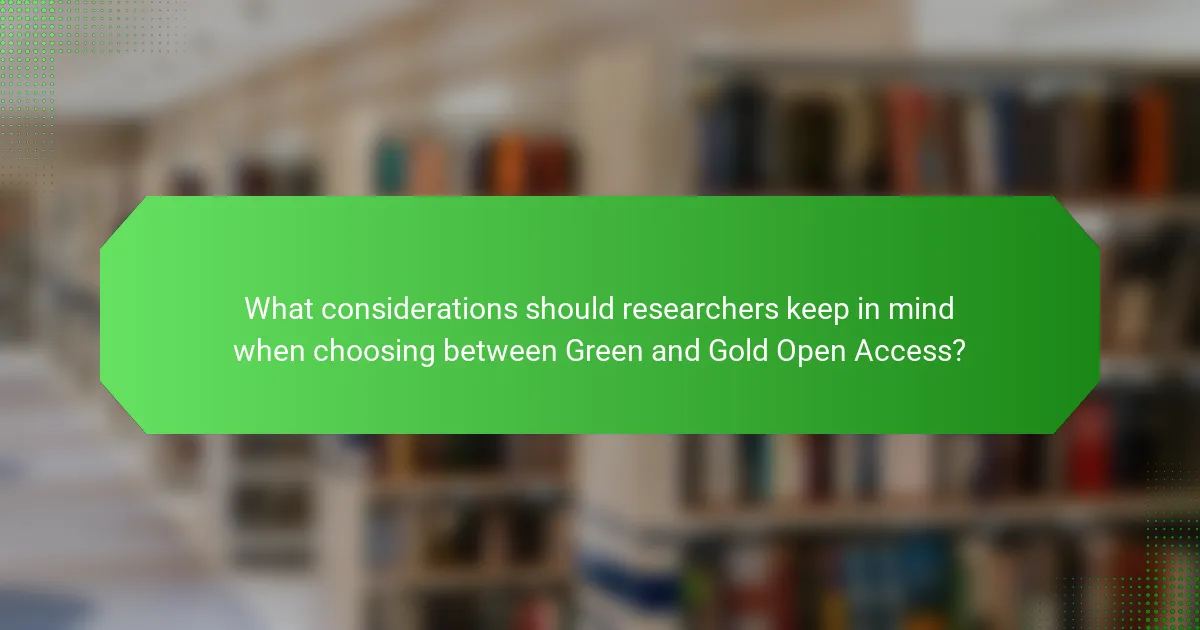
What considerations should researchers keep in mind when choosing between Green and Gold Open Access?
Researchers should consider funding availability when choosing between Green and Gold Open Access. Gold Open Access often requires upfront article processing charges (APCs). Researchers must assess if their institution or grant covers these fees. Green Open Access typically allows self-archiving without fees. The target audience is another key consideration. Gold Open Access journals may have wider visibility due to their open nature. Researchers should evaluate the journal’s impact factor and reputation. Publication speed can also differ; Gold Open Access may offer faster publication timelines. Lastly, licensing terms vary; researchers should understand the rights retained through each option.
What factors influence the decision to choose Green or Gold Open Access?
The decision to choose Green or Gold Open Access is influenced by several factors. Key factors include funding availability, institutional policies, and author preferences. Green Open Access often requires less financial investment as it allows authors to self-archive their work. Gold Open Access typically involves article processing charges, which can be a barrier for some authors. Institutional support for either model can significantly impact the choice. Additionally, the visibility and reach of the publication may sway authors towards Gold Open Access. The specific field of study can also dictate preferences, as some disciplines favor one model over the other.
How do funding sources affect the choice between Green and Gold Open Access?
Funding sources significantly influence the choice between Green and Gold Open Access. Researchers often select Gold Open Access when their funding includes specific mandates for immediate open access publication. This model typically requires payment of article processing charges (APCs) upfront. In contrast, Green Open Access is favored when funding sources allow for self-archiving of articles in repositories without immediate fees. Studies show that institutions with strong support for open access often prefer Gold due to the visibility it provides. Meanwhile, funding bodies that prioritize cost-effectiveness may encourage Green Open Access to minimize expenses.
What impact does institutional policy have on Open Access choices?
Institutional policy significantly influences Open Access choices. Policies can dictate the preferred models of Open Access, such as Green or Gold. For instance, some institutions may mandate that researchers publish in Gold Open Access journals. This can lead to increased visibility and accessibility of research outputs. Conversely, institutions that support Green Open Access may encourage self-archiving in repositories. This allows researchers to retain more control over their work. Institutional funding for publication fees also affects choices. If funding is available for Gold Open Access, researchers are more likely to choose this route. A study by Laakso et al. (2011) found that institutional policies directly shape authors’ publication behaviors. Therefore, the alignment of institutional policies with Open Access models plays a crucial role in shaping research dissemination practices.
What best practices can researchers follow when navigating Open Access options?
Researchers should evaluate the credibility of Open Access journals. They can utilize resources like the Directory of Open Access Journals (DOAJ) for reliable listings. Researchers should also consider the journal’s impact factor and reputation within their field. Understanding the licensing agreements is crucial to ensure compliance with copyright laws. Researchers must also assess funding options for Open Access fees, as some institutions provide grants. It is beneficial to review the journal’s peer review process to ensure quality. Lastly, maintaining transparency about Open Access choices can enhance collaboration and visibility in the research community.
The main entity of this article is the comparison between Green and Gold Open Access publishing models. It provides a detailed overview of their definitions, characteristics, advantages, and publication processes. Key differences include the self-archiving nature of Green Open Access, which allows authors to retain copyright and share their work after an embargo, versus the immediate availability and article processing charges associated with Gold Open Access. The article also discusses the roles of publishers in both models, considerations researchers should account for when choosing between them, and best practices for navigating Open Access options.
